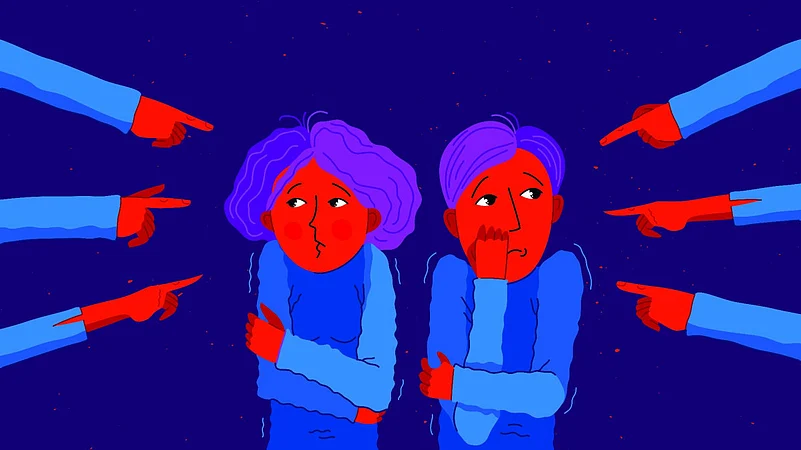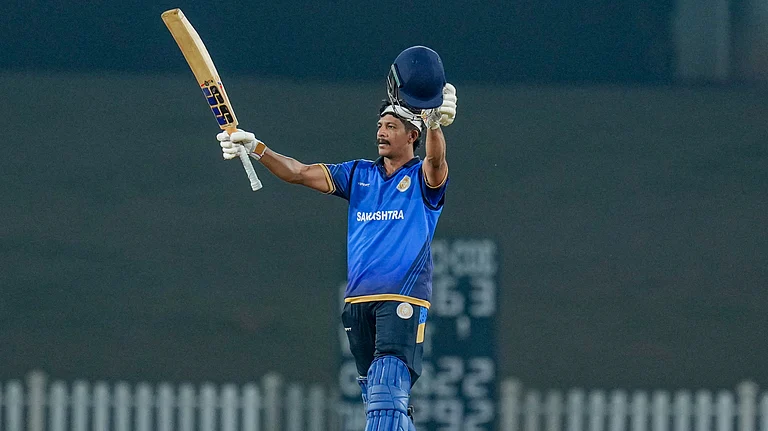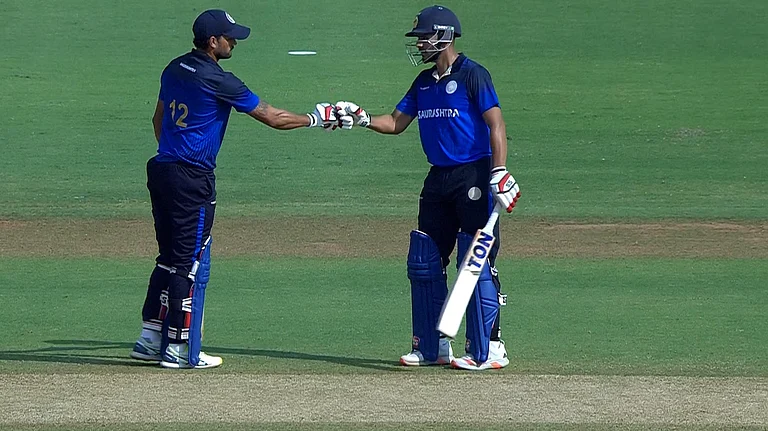The ‘English medium schools, which have now become the only option for the Indian middle class to send their children to, have also forayed into villages and towns over the years, but apart from a CBSE or ICSE curriculum, the schools are far from becoming hubs of liberal thinking which a western education system is expected to be.
Barring some top schools in the metros like Delhi, Mumbai or Kolkata, the wider network of so-called English medium schools, continues to be the breeding ground of gender discrimination where girl students often reveal that they are shamed or judged on their behavior and even minimised as opposed to their male classmates.
A thread on social media, where students were discussing a string of objectionable comments from teachers levelled against students, took us on a trail of a few schools across the country. Girl students of most of them revealed that they have at some point or the other have faced gender-based discrimination which has also been on the verge of insults. Some have also claimed that they have been labelled to be of "poor character" and more, in the form of personal attacks from teachers.
The question of safety of the ‘English medium schools’ looks suspect as there is no gauge for how a teacher is expected to behave with a student in close quarters.The students usually do not find an open neutral sounding board for verbal abuse.
Here are some of the experiences shared by students to us:
Segregation is mistaken as social order by teachers
Segregation of the sexes is a widespread practice in these schools. From seating arrangements in classes to assemblies and even lunch areas, opposite sexes aren’t allowed to interact with each other. Yes, you read that right, one of the respondents told us that they had an imaginary line in the middle of their school’s lunch area, guarded by physical education teachers. Anyone crossing into the area of the opposite sex would be forced to pick up 10 pieces of litter at the end of the lunch period to compensate for their sin.
The mindset that goes behind the segregation of sexes in the schools works on the desire of the authorities to prepare the students for an ‘ideal social order’. Thank the constitution-makers, at least segregation based on caste has been criminalised.
This segregation of sexes paves way for an array of stereotypes to kick in. Japharneet said, “In my school, girls were sent to a dance class and boys to learn instruments during the activity period.” She doesn’t understand the point of segregation in these artistic activities. “Are they planting the message of ‘meri ungliyo pe naach’ in the minds of the kids?” she wonders.

Gender Stereotyping is very much prevalent
Schools are the places of unlearning stereotypes that have existed since time immemorial, especially in Indian society. “Sit like a girl,” Deeksha remembers being told by her class 10th biology teacher. What was her mistake? She was sitting with a two feet gap between her knees, mirroring her male benchmate. Yashaswini, a graduate from an all-girls school, tells us she was always made feel bad for being, “too opinionated for a girl.” Now that she experiences freedom in a liberal college, she gets appreciated for her traits and feels confident about them.
Urvashi tells, “We had a no-jeans dress code for female teachers. Whereas, the male staff was allowed to wear jeans in the school.” The no-jeans-for-female-staff rule is very famous in Indian schools. Pondering over the thought of why the same piece of clothing could be considered appropriate for one gender and inappropriate for the other, we reached out to the principal of such a school, who chooses to remain off the record. She told, “The message is to carry yourself properly. Even for the male staff, we have the rule of not allowing them to wear t-shirts in the school.”
The idea that jeans is considered ‘improper’ for a woman to wear can be shielded by establishing such false equivalences. Every school would justify this code but in reality, women have far more clothing restrictions than men.
Misogyny has become a part of life and teachers don’t fall from heaven
Though the NCERT is trying to incorporate ‘Gender Equality’ guidelines in the schools, its success has a long way to go. “Just because a teacher is going to school and teaching the kids, doesn’t mean they will forget who they really are. Their upbringing is carried out in the same stereotypical environment at their homes and that’s what they project onto the young minds.” said Dr. Shubra Sanyal, a psychologist retired from the National Institute of Criminology and Forensic Science, MHA, who also wrote the book, ‘Save the Children’ for NCERT.
A social sciences teacher told us on the condition of anonymity, “We had topics related to gender sensitisation during our B. Ed. but students never really paid attention to them. Moreover, the misogynistic environment in the colleges reduced the topics to mere bookish principles. Thanks to the internet, today’s teachers are realising problematic parts of the conventional pedagogy we are cultured in.”
Imagining the hierarchies in the schools as a class society, the concept of false consciousness, by Friedrich Engels comes into picture. The underclass(students) assert itself toward goals (accepting stereotypes) that do not benefit it (but the ruling class - teachers). Devoid of critical thinking at their young age, students embody this problematic ideology of the teachers and think it’s essential for their society to prosper. Such stereotyping then reflects on children’s behaviours. For example, it’s generally seen that girls refrain from talking about sex/sexuality for the most part in their school lives and even beyond, while the boys are relatively free to do that. For boys, school becomes the primary ground where their toxic masculinity trait of “men don’t cry” is conditioned.
But what if there are outliers? What if unruly students stop conforming to stereotypes imposed on them?
Punishments as way of reinforcing stereotypes
Meant to make a person more disciplined, punishments often end up traumatising and injecting problematic behaviour into school students. Boys are on the more violent side of the punishment like doing rounds of the school ground or getting thrashed by the teachers (which fortunately has drastically come down now). On the other hand, girls are let go of the physical violence but are questioned on very personal concepts like ‘character’ and ‘integrity’. Jona, a second-year law student tells us, “When school teachers refrained from giving physical punishment to girls, they assumed they were on some moral high ground and that gave them an opportunity to show more passive-aggressive behaviour towards us.” The strenuous effort of 50 sit ups might be physically challenging but the ensuing cold behaviour towards girls and calling them names can cause psychological distress and be much worse.
An interesting phenomenon to observe here is that femininity is considered to be a degraded gender trait in schools and events like punishing boys with long hair by tying them into a ponytail are actually reinforcing that. It is also reinforcing the idea that only girls can tie their hair using a rubber band to such an extent that boys even start to cry when their hair are tied like that as a punishment.

Inadvertent Slut Shaming – “The Characterless girl”
Calling girls, “sluts” out in the open can put teachers in a lot of trouble, so the teachers resort to the word “characterless”. Pranjal tells us, “Throughout our high school, girls were constantly reminded of their characterlessness.”
Most of the Indian girls will resonate with the word ‘characterless’ as it is a universally accepted term for subjugating the feminine gender. Forget lengths of the skirt, the way girls sit, the volume at which they laugh and their amicability with boys are some of the many factors which can define the ‘character’ of the girls in schools. “We were told to not tie a ponytail, rather tie the hair into plaits,” said Manya. She tells us that most of the schools despise girls who show up with untied hair or even bangs. “Apparently, the teachers think that if girls untie their hair, boys will be attracted to them… as if a changed hairstyle could mean anything more than a personal choice for us,” she says, ridiculed. Pranjal tells us, “The schools had such a big problem with the lengths of our skirts that they eventually changed the uniform to pants, for everyone.” Guess we have gender neutral dress codes for way different reasons.
While the Physical Education teachers, the henchmen of school administration stay busy with schooling the boys, the female staff is, with enforcing misogynistic standards in the schools.
Women being the enemies of Women
“We always teach our daughters to stay inside homes. But we never teach our sons to behave.” Sagar said, quoting his principal from a school seminar. Only a few moments later, he said, the teacher asked a girl “Hey! why are you sitting in the boys’ row?” Irony dies a slow death when schools, the epitome of female staff representation become hubs of perpetration of misogyny.
A lot of moral education in schools revolves around supressing women and teaching the concept of victim blaming. Gargi tells us about an incident, “I once slapped a guy who wrote ‘f**k you’ next to my name in the washroom for no reason. The whole thing spun around and came back to my ‘character’ somehow. Even my class teacher, who was a woman, told me that whatever the guy did was wrong but as a girl, I should be more cautious. While the boy was let off the hook, I was told that men could harm me (tumhare saath kuch bhi ho sakta hai) when I commute back from school or my office in the future.”
She says that such incidents discourage women to rebel and it feels like as if she was teaching, “Misogyny is here to stay but we, as women, need to ensure that we don’t counter it enough that it becomes a danger for us. Basically, let the men do anything.”
Dr. Sanyal, who also works for the rehabilitation and reintegration of juveniles in conflict with law comments on it, “With such encounters with sexism, girls start withdrawing themselves from their social lives and get traumatised. The extent of bullying by teachers reaches to such a level that girls start mirroring this behaviour and turn against each other. Some even find themselves not being able to share their problems which can lead them to find recusal through drugs.”
Living in a gender-insensitive society, it should be an important duty of the schools to sensitize the children about misogyny all around them. Although conducted with genuine concern for the girls, the seminars teaching them about periods are prohibited for the boys. Sneha tells us, “A teacher once came into our class and took away the girls to the seminar hall. We were taught about periods by a gynecologist and it was really helpful. What made much sense back then but seems really problematic now is the fact that boys were excluded from that session. Moreover, we were given strict instructions to not tell the boys about what happened in there. It was a big surprise that absolutely no one opened their mouths after the seminar. All the guys were so perplexed.”
When we reached out to a school principal to know the reason behind such restrictions, she said that it was a very “uncomfortable” topic to discuss with the boys. But nevertheless, schools are moving in the direction of conducting those workshops for both the sexes.
What schools fail to see is that because of such discomforting topics for schools, boys often end up making insensitive comments like, “Are you PMSing?”
Inclusivity? We only know 2 genders!
“We were not allowed to discuss topics like sexual orientation in our school’s debate club,” said Mehar, who graduated from a convent school. The interference of the Church in English medium education in India is more than any other religious institution. The biblical standards of sexuality and sexual orientation are therefore prevailing over 21st-century scholarship. She adds, “Girls were even questioned for having a ‘boy cut’ hairstyle.”
Dhruv tells us, “Our school appointed a ‘mannerism teacher’ and she prohibited even girls-girls or boys-boys holding hands because she thought that it looked ‘awkward’.”
With the use of the ‘elite’ English language, the English medium education in India is conveniently leaving out the liberal model of morals and society of the west.
Dr. Sanyal said, “The elite schools of metropolitan cities are brands within themselves. Therefore, their priority often becomes to protect their ‘honour’ and they end up blowing these acts out of proportion.” She terms their definition of honour as a “half-baked blend of modernity and orthodoxy.”
(The names of some respondents have been changed)

























